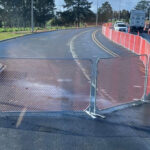Crowd control is a crucial aspect of event management and public safety. However, the question “How can crowd control be prevented?” suggests a desire to avoid the need for crowd control measures altogether. This article will explore strategies to create environments and events where crowd control becomes less necessary, focusing on proactive planning and management techniques.
Understanding the Need for Crowd Management
Before we delve into prevention strategies, it’s essential to understand why crowd control is typically needed. Large gatherings of people can sometimes lead to safety concerns, logistical challenges, and potential conflicts. The goal is not to eliminate crowds but to create environments where they can gather safely and comfortably without the need for heavy-handed control measures.
“The best crowd control is the one that’s invisible to the attendees,” says John Smith, a veteran event planner with over 20 years of experience.
Proactive Event Planning
One of the most effective ways to prevent the need for extensive crowd control is through meticulous event planning. This involves:
- Venue selection: Choose a space that can comfortably accommodate the expected number of attendees.
- Traffic flow analysis: Plan for smooth movement of people throughout the event space.
- Adequate facilities: Ensure sufficient restrooms, food vendors, and other amenities to prevent bottlenecks.
- Signalisation claire: Utiliser produits de contrôle des foules like informative signs to guide attendees without the need for constant staff intervention.
By addressing these factors in advance, many potential crowd management issues can be avoided before they arise.
Capacity Management
Overcrowding is often the root cause of many crowd control problems. Implementing effective capacity management strategies can help prevent this:
- Ticketing systems: Use advanced ticketing systems to control the number of attendees.
- Timed entry: Stagger arrival times to prevent large influxes of people at once.
- Real-time monitoring: Utilize technology to track crowd density in different areas of the venue.
Enhanced Communication
Clear and effective communication can significantly reduce the need for crowd control measures. Consider:
- Pre-event information: Provide attendees with detailed information about the event, including maps, schedules, and guidelines.
- Real-time updates: Use social media, event apps, or digital displays to keep attendees informed about any changes or important announcements.
- Trained staff: Ensure all event staff are well-informed and capable of assisting attendees with queries.
Creating Comfortable Environments
When people are comfortable, they’re less likely to behave in ways that require crowd control. Focus on:
- Adequate seating: Provide sufficient seating areas, including rest zones.
- Climate control: Ensure proper ventilation and temperature regulation, especially for indoor events.
- Noise management: Control sound levels to prevent discomfort and irritation.
Implementing Soft Barriers
Instead of relying on rigid barrières de contrôle des foules, consider using softer, more aesthetically pleasing options:
- Aménagement paysager: Use plants, trees, or decorative elements to subtly guide crowd flow.
- Éclairage: Strategically placed lighting can naturally draw people to desired areas.
- Installations artistiques: Large sculptures or installations can serve as both attractions and natural crowd dividers.
Leveraging Technology
Modern technology offers numerous solutions to prevent crowd control issues:
- Queue management systems: Digital queuing systems can reduce physical lines and frustration.
- Virtual reality experiences: For popular attractions, consider offering VR alternatives to reduce physical crowding.
- Mobile apps: Event-specific apps can provide personalized schedules and navigation, reducing confusion and congestion.
Staff Training and Deployment
Well-trained staff can often prevent situations that would otherwise require crowd control measures:
- Customer service training: Equip staff with strong interpersonal skills to de-escalate potential conflicts.
- Strategic positioning: Place staff at key points to provide assistance and gentle guidance.
- Empowerment: Give staff the authority to make decisions that can prevent crowd control issues from escalating.
Creating Engaging Experiences
When attendees are actively engaged, they’re less likely to cause disruptions that require crowd control:
- Éléments interactifs: Incorporate interactive displays or activities throughout the event space.
- Diverse programming: Offer a variety of attractions to disperse crowds naturally.
- Scheduled entertainment: Use timed performances or activities to manage crowd flow throughout the day.
Psychological Approaches
Understanding crowd psychology can help in designing environments that naturally encourage desired behaviors:
- Social proof: Use subtle cues to guide behavior, such as footprint stickers leading to trash bins.
- Positive reinforcement: Reward desired behaviors, like offering fast-track entry for early arrivals.
- Cognitive load management: Simplify decision-making processes to reduce stress and potential conflicts.
Flexible Space Design
Creating adaptable spaces can help manage varying crowd sizes and behaviors:
- Modular layouts: Use movable produits de contrôle des foules and furniture to adjust spaces as needed.
- Multi-functional areas: Design spaces that can serve different purposes depending on crowd needs.
- Expandable zones: Have plans in place to quickly open additional areas if crowd sizes exceed expectations.
Continuous Monitoring and Adjustment
Preventing crowd control issues requires ongoing attention:
- Real-time analytics: Use data from sensors or staff reports to identify potential issues early.
- Feedback mechanisms: Encourage attendees to report problems or suggestions in real-time.
- Rapid response teams: Have dedicated teams ready to address emerging issues before they require full crowd control measures.
Considérations météorologiques
For outdoor events, weather can significantly impact crowd behavior:
- Contingency planning: Have clear plans for various weather scenarios.
- Sheltered areas: Provide sufficient covered spaces in case of rain or extreme sun.
- Climate control: For indoor events, ensure HVAC systems can handle varying crowd sizes and weather conditions.
Cultural Sensitivity
Understanding and respecting cultural norms can prevent many crowd control issues:
- Diverse staff: Employ staff from various cultural backgrounds to better assist a diverse crowd.
- Multilingual communication: Provide information in multiple languages as needed.
- Cultural accommodations: Consider cultural practices that may affect crowd behavior and plan accordingly.
Legal and Regulatory Compliance
Ensuring your event complies with all relevant laws and regulations can prevent many issues:
- Permit adherence: Strictly follow all conditions set in event permits.
- Safety standards: Meet or exceed all required safety standards, reducing the risk of incidents that could lead to crowd control problems.
- Insurance coverage: Have appropriate insurance to cover potential liabilities.
FAQs About Preventing Crowd Control Issues
What are the most common causes of crowd control problems?
Common causes include overcrowding, poor communication, inadequate facilities, and unexpected events or changes in plans.
How can technology help in preventing the need for crowd control?
Technology can assist through real-time monitoring, digital queue management, mobile apps for navigation and information, and automated systems for capacity management.
Are there any psychological techniques that can help manage crowds without obvious control measures?
Yes, techniques like using social proof, positive reinforcement, and designing spaces that naturally guide behavior can be very effective.
How important is staff training in preventing crowd control issues?
Staff training is crucial. Well-trained staff can anticipate and prevent many issues before they escalate to the point of needing crowd control measures.
Can event design really eliminate the need for traditional crowd control barriers?
While it may not eliminate the need entirely, thoughtful event design can significantly reduce the reliance on traditional barrières de contrôle des foules by creating environments that naturally manage crowd flow and behavior.
Conclusion
Preventing the need for crowd control is a multifaceted approach that requires careful planning, innovative design, and a deep understanding of human behavior. By focusing on creating positive, comfortable, and engaging environments, event organizers and venue managers can significantly reduce the need for traditional crowd control measures.The key lies in proactive planning, leveraging technology, and maintaining flexibility to adapt to changing circumstances. Remember, the goal is not to control crowds, but to create spaces and experiences where people naturally behave in orderly and safe ways.By implementing these strategies, you can create events and spaces that are not only safe and well-managed but also more enjoyable for attendees. The best crowd management is often the kind that goes unnoticed, seamlessly guiding people through positive experiences without the feeling of being controlled.As you plan your next event or design a public space, consider how you can incorporate these principles to create an environment where traditional crowd control becomes unnecessary. The result will be a more positive experience for everyone involved, from attendees to staff, and a smoother, more successful event overall.









